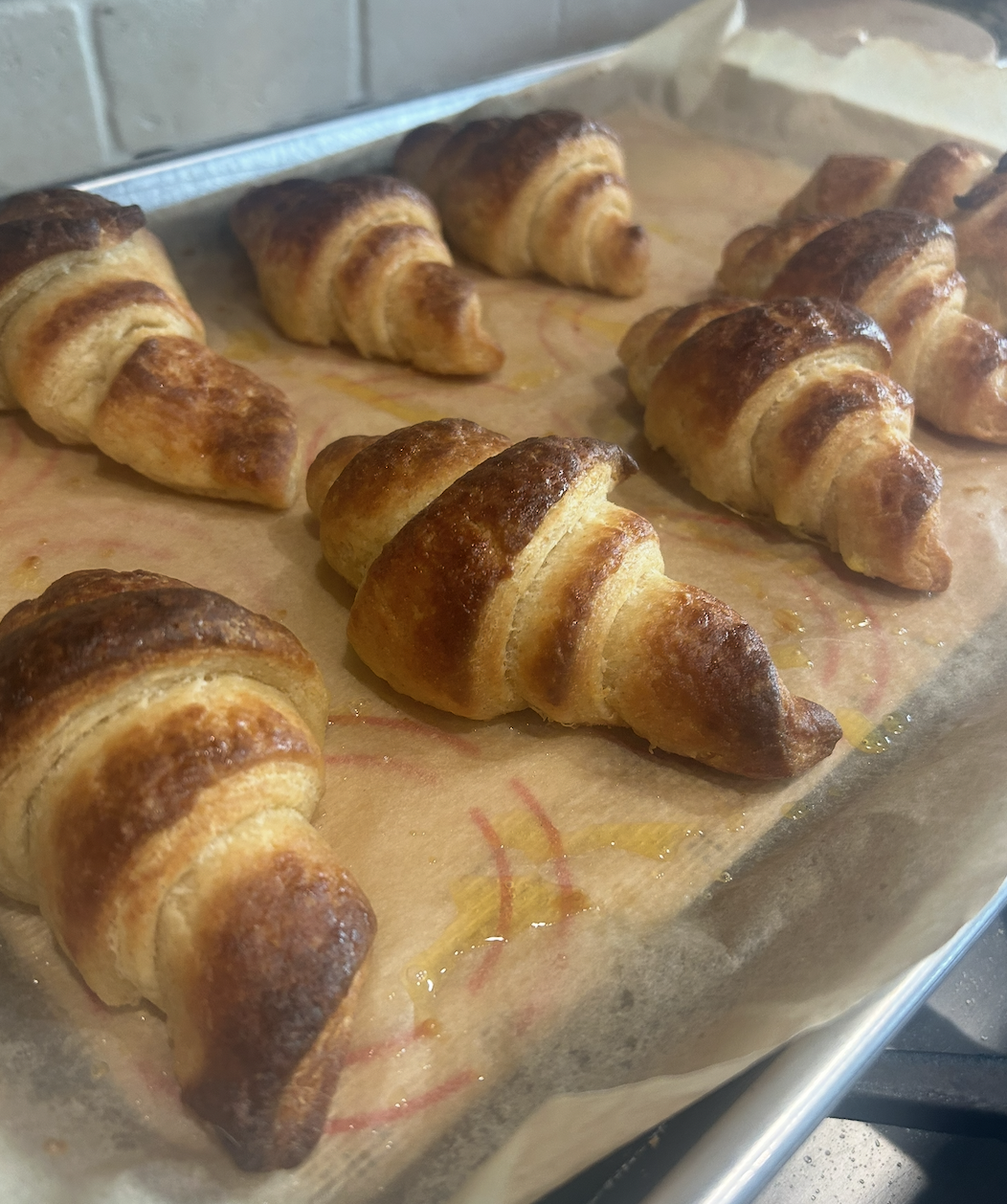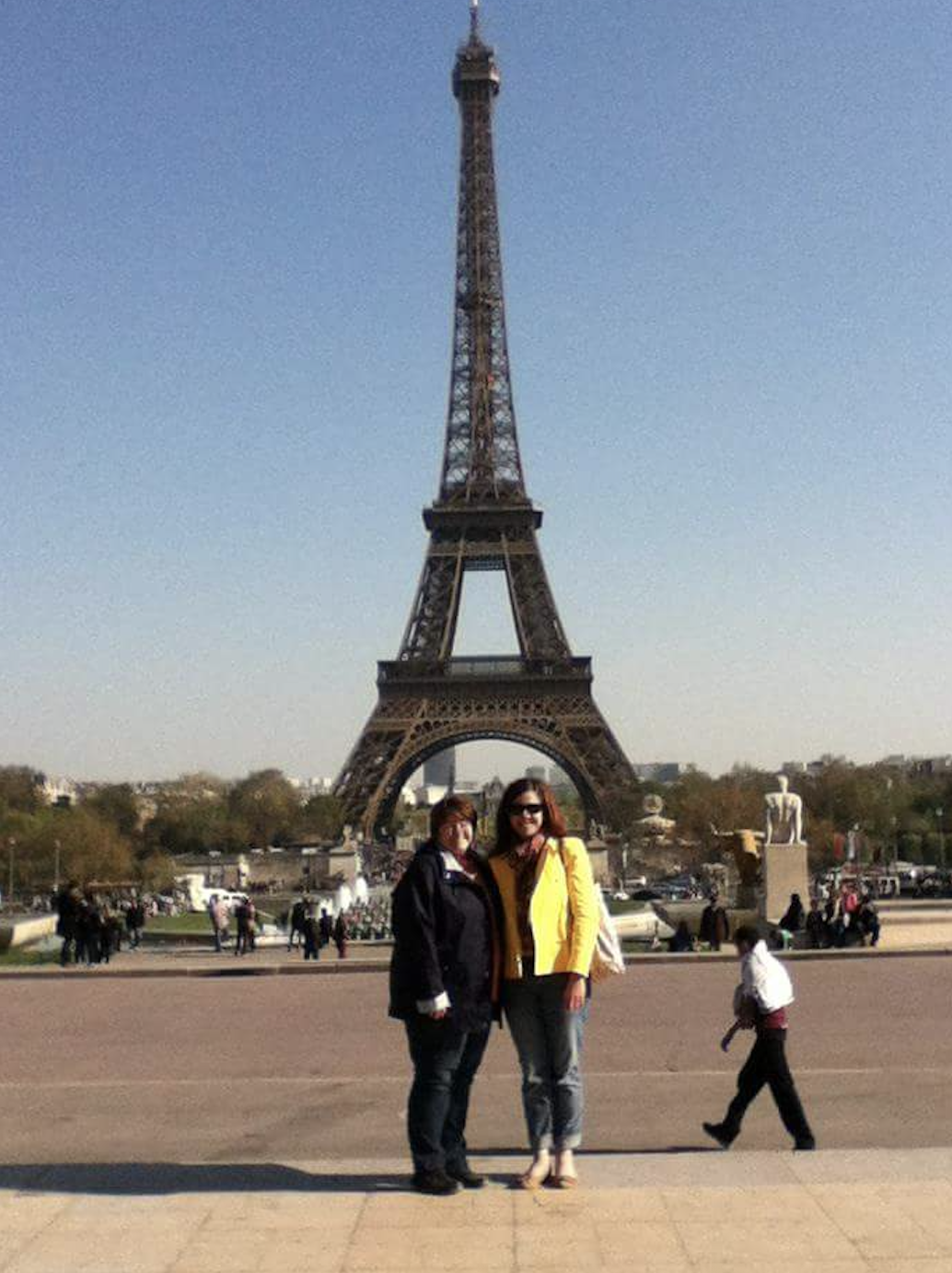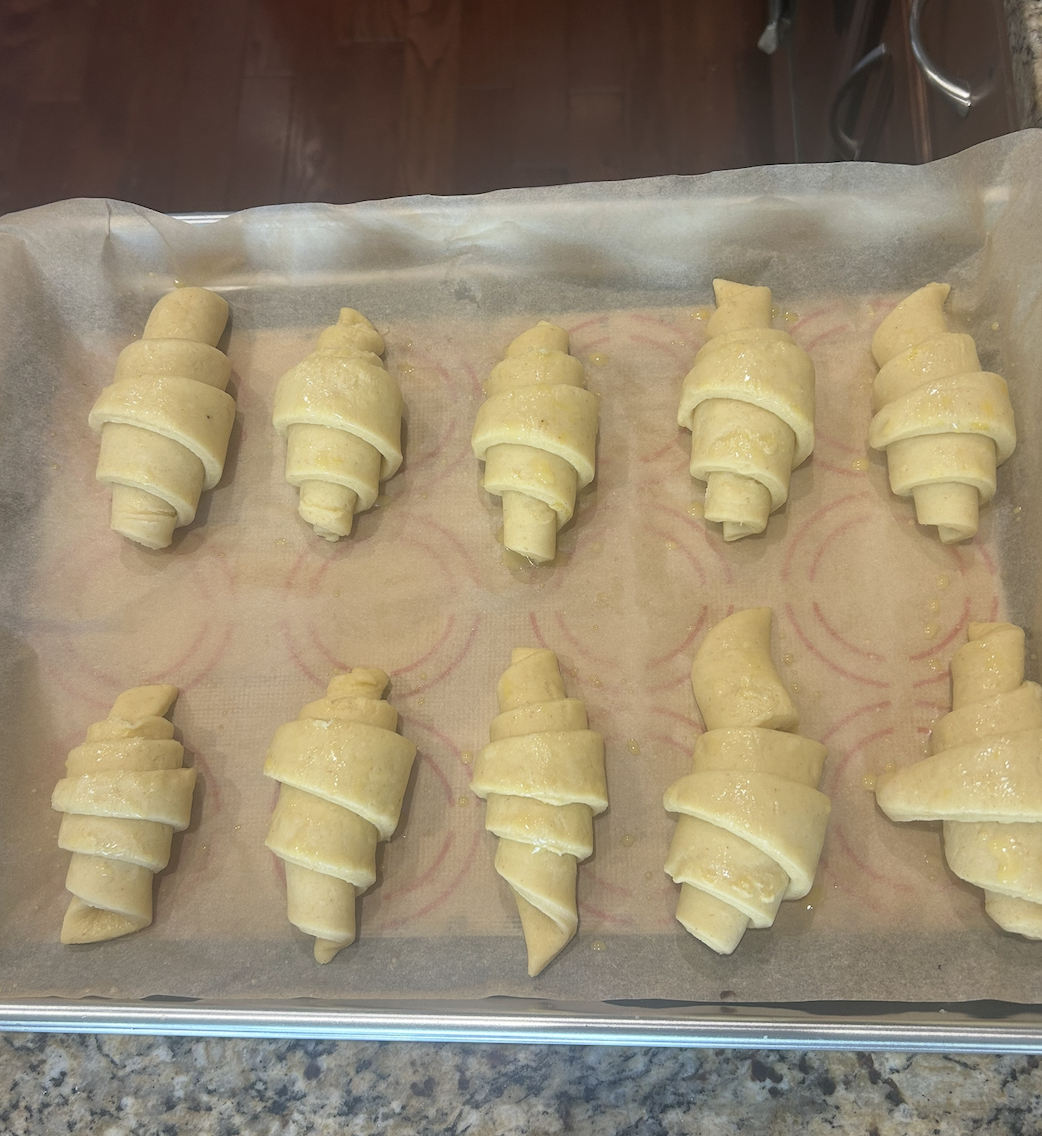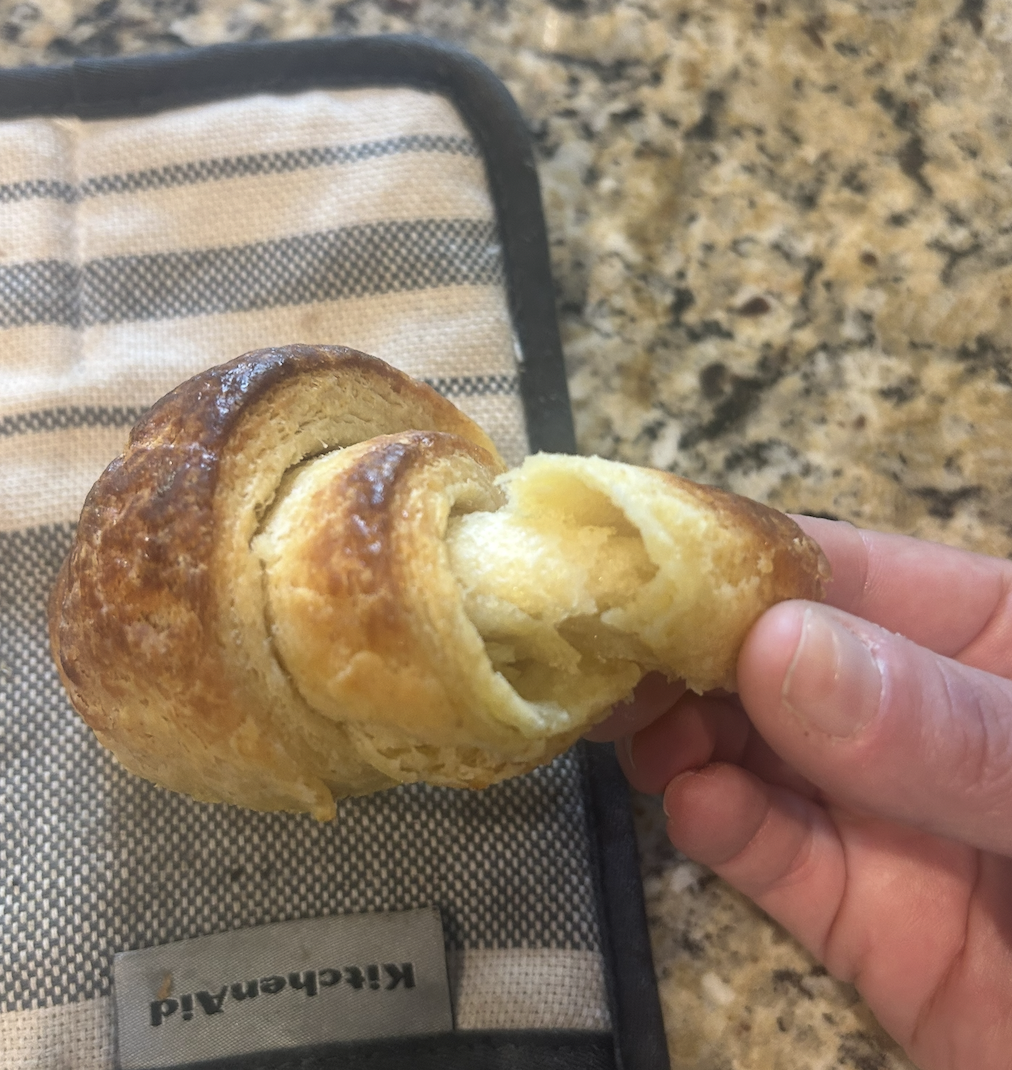A Thousand Layers of Memory: My First Gluten-Free Croissants
The scent of flour still lives in my hands. Even after years away from the kitchen, I can close my eyes and feel the weight of a dough scraper, the cool marble counter beneath my palms, the soft exhale of yeast waking in warm water. Those memories rise like bread dough — slow, inevitable, alive.
When I pull out my chef’s knife — the one with my initials etched into the blade by an ex-husband in a baking lab long ago — I remember who I was when I first wore my black-and-white checkered pants. I was a girl learning to carve her place in a world of kitchens that smelled of butter, onions, and ambition. My hands still remember the rhythm of chopping, folding, and stirring. The language of food is one the body never forgets.
Where It All Began
My love affair with baking began early. I grew up in a kitchen that smelled like home — butter softening on the counter, sugar dissolving into eggs, flour swirling in the air like the first snowfall of winter. My mom taught me the joy of measuring and mixing, of waiting and watching. We baked together often — cookies, quick breads, birthday cakes.
By the time I reached junior high, I was baking bread one to three times a week after school. It wasn’t a chore; it was a ritual. While my friends were watching TV or hanging out at the mall, I was in our warm kitchen, kneading dough until my forearms ached and the room filled with the scent of transformation. I loved that moment when simple ingredients — flour, water, yeast, salt — turned into something alive.
Cookies became my language of love. I could make them without a recipe, relying only on memory and instinct. It felt like magic. I didn’t know it then, but those after-school loaves were the first lessons in alchemy — the kind of intuitive transformation that would one day define both my career and my spirituality.
The Youngest in the Kitchen
When I graduated high school, there was no question where I was headed: culinary school. I was barely eighteen — the youngest student in my class and one of only three women. Most of my classmates were men in their late twenties and thirties, already working in professional kitchens, earning their degrees so they could move up to executive chef.
The first few weeks were humbling. They laughed when I struggled with my knife cuts or when my hollandaise broke for the third time. My hands shook each time I tried to perfect a tourné potato. I felt small and out of place, a girl in a world of men with burns on their forearms and stories from the line.
But everything changed in our second quarter, when we entered the world of baking and pastry.
The first assignment was croissants. I still remember the instructor describing them: “A thousand layers — butter and dough folded into one another until they become inseparable.”
The class groaned. Laminated dough terrified even the most confident cooks. But when I began rolling and folding, something in me relaxed. I didn’t think — I felt. My hands knew what to do. I turned the dough, brushed away the flour, folded it like a secret.
Hours later, when we pulled our trays from the ovens, the men around me had flat, dense pastries. Mine were golden, delicate, flaky — and when I bit into one, the layers shattered perfectly. The room went quiet.
After that, no one teased me again.
Through tiramisu, ladyfingers, and breads that rose like small miracles, I found my rhythm. Pastry was patience and precision, intuition and surrender. It was my language.
Dreaming of Paris
Like every pastry student, I dreamed of Paris — of studying at the Ritz Escoffier, of walking cobblestone streets before dawn to deliver perfect croissants to a sleepy café. I wanted to learn the recipes that never made it across the Atlantic, to taste the art of true gastronomique.
To me, the word croissant meant more than pastry. It meant devotion — a thousand folds of care, a ritual of love that could turn butter and flour into transcendence.
Life, of course, took me in other directions. But the dream of Paris stayed tucked inside, like a recipe waiting to be baked.
Easter in Paris, 2012
In 2012, that dream finally rose.
It was Easter, and I was on a plane bound for Paris with my mom. I remember pressing my forehead against the window as the sun rose over France. The hills looked painted — soft green with lines of vineyards etched like wrinkles of wisdom. When the plane banked, I saw it: the Eiffel Tower gleaming in the early light, just as I’d imagined it for years.
Seeing my mom waiting for me at the airport felt like coming full circle. The woman who’d taught me to bake was now beside me in the city of pastry itself. We spent our days walking by the River Seine, wandering through markets and book stalls, our hands dusted with baguette crumbs.
At the time, I was both gluten- and dairy-free. But standing in front of glass cases filled with croissants and tarts, I made a decision: I was going to eat the gorgeous foods of France, allergies or not.
And so I did. I ate everything — croissants so buttery they melted on my tongue, brioche so light it dissolved in air, cheese so fragrant it flirted with my senses.
It’s true what travelers say: the flours in France are different. The grains are less hybridized, the fermentation slower, the bread somehow more alive. My body digested it easily, as if recognizing something familiar and ancient.
Those days were bliss — a communion of flavor and memory. The light, the art, the food — all of it awakened something in me. Paris reminded me that food is not just nourishment; it’s intimacy, it’s spirit, it’s love made tangible.
The Long Pause
After Paris, life changed — as life always does.
My career moved toward coaching, healing, and Ayurveda. I still cooked, of course, but baking — the kind of all-day, flour-covered, soul-immersed baking — drifted away.
There was practicality to it. Gluten and yeast were no longer my allies. My body, always my greatest teacher, demanded new ingredients, new rhythms. I learned how to nourish myself differently. Still, a part of me missed the music of baking: the soft rustle of parchment paper, the hum of the mixer, the way time itself bends while dough rises.
For years, that longing sat quietly in the background — until recently.
Returning to My Baking Roots
This past month, something inside whispered, “It’s time.”
Maybe it was the change of season or the way nostalgia has a scent all its own. Whatever the reason, I found myself craving the rhythm of baking again — not the convenience of a quick muffin, but the slow, meditative devotion of pastry.
Late one night, scrolling through gluten-free recipes, I discovered an incredible blog called Let Them Eat GF Cake. The photos stopped me in my tracks — golden breads, intricate pastries, and, yes, croissants. Gluten-free croissants.
The recipes were complex and beautiful, the kind that required patience and precision — just like the ones I learned in school. I could feel that old excitement stirring again.
I decided to do it.
It took two full weeks to gather everything I needed: specialty flours, starches, psyllium husk, and butter that would hold its shape through lamination. I researched blends, ordered ingredients online, and reorganized my kitchen. The process itself felt like a homecoming.
When the day finally came, I set aside the entire weekend. The first day was mixing and folding, the second was shaping and baking. The dough was different — softer, more delicate — but I found myself moving with familiar grace. Each fold felt like a meditation, a conversation between who I was and who I’ve become.
When the croissants finally came out of the oven, I stood in front of them like a proud mother. They were golden, flaky, fragrant — the same buttery aroma I remembered from culinary school, only now layered with gratitude.
The first bite brought tears. It was perfect. A thousand layers of memory, patience, and joy.
The Alchemy of Food and Memory
As I savored that first croissant, I realized that food carries memory in its molecules. Every bite connects us to where we’ve been — to the hands that taught us, the rooms that warmed us, the laughter that accompanied our first successes.
Baking has always been alchemy for me — a physical expression of transformation. In the kitchen, we learn that change is not destruction but creation. Flour becomes bread. Milk becomes butter. Grief becomes wisdom.
When I switched to gluten-free baking, I had to relearn everything I thought I knew. Different flours, new ratios, altered techniques — it demanded humility and curiosity. But that’s the gift of reinvention: it keeps us alive, awake, willing to be surprised.
Food, like life, asks us to adapt. We rise, fall, and rise again.
The Spirit of Return
Standing in my kitchen now — older, wiser, more attuned to my body — I see baking as a metaphor for self-trust. When you knead dough, you have to feel it, not force it. The same is true for life.
The young girl who baked bread after school did so out of joy. The culinary student baked to prove herself. The woman I am today bakes to remember.
Every phase of my life has had its own recipe: some complex, some simple, all teaching me something about surrender and timing.
Maybe that’s what a croissant really is — the perfect symbol of rebirth. Butter and flour folded together again and again until they become something new. Strength and tenderness, work and grace, coexisting in golden harmony.
An Invitation to Remember
As I write this, the last of those croissants are cooling on the counter. The kitchen smells like heaven — buttery, warm, alive. I feel both grounded and lifted, connected to every version of myself that ever dared to create.
I can’t help but wonder: What did you love as a child that you’ve let slip away?
Was there something that once made you feel alive — painting, singing, writing, gardening — that you’ve tucked into the back corner of your life, waiting for a quieter day?
Perhaps it’s time to open that door again.
Baking these croissants reminded me that we never lose the passions of our youth; we simply forget to feed them. And when we finally do, they rise again, just like dough given warmth and patience.
So I invite you to pause. Pour yourself a cup of tea. Close your eyes and think back to what you loved before the world told you who to be.
What textures, sounds, and smells defined your early joy?
What activity made you forget time existed?
What did you create simply because it felt good?
Let that memory rise within you. Then, find one small way to honor it this week. Maybe it’s dusting off an old sketchbook, singing in the shower, or, like me, rolling out a new kind of dough.
Because joy, like yeast, is a living thing — it only needs a little warmth to grow.
Recipe Notes
For those who feel inspired to try their own batch, you can find the gluten-free croissant recipe that sparked my revival on Let Them Eat GF Cake. The author’s precision and creativity reminded me of the artistry I fell in love with so many years ago.
If you decide to try them, give yourself time — this is not a quick recipe, but it is a sacred one. The process itself is therapy: two days of patience, intention, and curiosity that culminate in pure magic.
And when you pull your croissants from the oven, golden and layered with love, I hope you taste what I did: the sweetness of remembering who you are.







